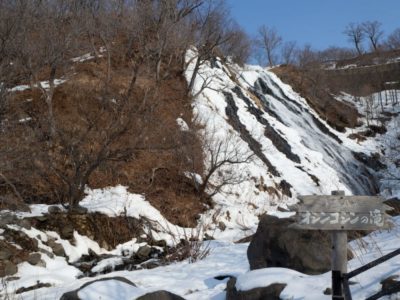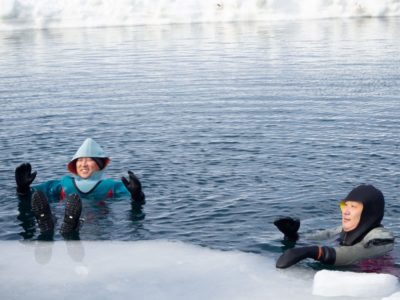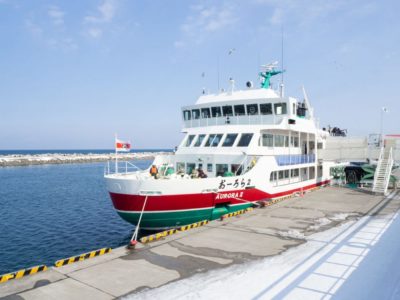Shiretoko-hanto is a peninsula in the north-east of Hokkaido. It is a little-explored region by most tourists because of its very remote location. But those who make it there will be rewarded with special experiences like drift ice walking, birding, and wild nature.

Shiretoko National Park
The word ‘shiretoko’ literally means ‘end of the earth’ in Ainu language, which was well-chosen. The part of the peninsula that is furthest into the east doesn’t even have roads which means that that part of the peninsula can either only be viewed from a boat departing from Utoro, or if you are a real lover of rugged areas by a multiple day trekking. There are steep mountain ranges and untouched forests, and it is a paradise for those who truly like to veer off the beaten paths. You can enjoy walking, hiking, trekking, camping, sea-kayaking, and star-watching in raw nature.
The peninsula has been designated as a National Park and UNESCO World Heritage site. If you make it all the way there, you will be treated to a large variety of wild animals like deer, foxes, brown bears, and sea eagles. You can also see many waterfalls, two of which are a warm waterfall that gives off steam and a waterfall that is split into two parts.
Drift Ice Experience

In winter, adventurous tourists come to the area to see and feel one of the northern hemisphere’s southernmost regions that has drift ice. There are tour operators that organize a drift-ice walk or even dive where you can see under the drift-ice.
These tours are available only between February 1st and March 23rd, and availability depends on temperature and weather circumstances. The tours happen 3 times per day, last for 3 hours and cost around 6000 yen per person. If you stay in a hotel in Shari, the hotel can recommend you a tour operator, and you will be picked up at your hotel.
Rausu Bird Paradise

Rausu is located on the east end of Hokkaido’s Shiretoko Peninsula. It is situated on the southeast corner of the peninsula facing the Nemuro Strait. The town lies along a small strip of land, extending 64 km from southwest to northeast. The Shiretoko mountain range, formed by past volcanic activity, is the source for multiple rivers. Because of the harsh topography and climate, a large part of the peninsula is accessible only by sea.
The area is covered in a primeval forest. Half of the region has been designated a special preservation district, so you need permission for access. Village communities are found mostly on the coastline at the ends of the rivers. The “downtown” of Rausu is at the mouth of the Rausu River. The primary industry in Rausu is fishing. Rausu attracts people for many reasons. Visitors come during the summer in the hopes of seeing whales, bears, and foxes.
Winter brings snow, drift ice on the sea, and the chance to take an ice-breaking cruise to see dolphins and the Stellar’s Sea Eagle. If you don’t mind the freezing temperatures, bird watching from a boat in winter is an amazing experience.
Abashiri

The Aurora ship is available from January 20 to April 3. You can take this boat from Abashiri city and enjoy Ryuhyo. A ride costs 3,500 yen per person.
Abashiri is a small city located on the Okhotsuku Coast of northeastern Hokkaido. You could say that Abashiri is the Japanese version of Alcatraz in San Fransisco. In addition to an abundance of seasonal seafood available throughout the year, it is also blessed with natural beauty, such as primeval flower gardens, lakes in summer, and ice floes in winter.
Winters here are harsh. During the winter months, ice flows from Russia clog the northeastern shore of Hokkaido, stretching out to sea for as far as the eye can see. The most popular way with the Japanese to view the ice flows up-close is to board an ice-breaking boat. Abashiri has lots of places to enjoy: Koshimizu Gensei-kaen (wildflower preserve), where about 40 kinds of flowers bloom in spring and summer.
Mt. Tento-zan in the suburbs is a great place from which to view Abashiri.In the Okhotsk Ryuhyo-kan (ice floe museum) you can see real ice floes even in the middle of summer, and experience a temperature of minus 15 degrees Celsius. Ice floes arrive in Abashiri every year in late January and you can walk on the frozen Ocean and even play ice hockey above it.


Your Japan Tour
As seasoned Japan experts, we create perfect Japan package tours including destinations like Hokkaido. Check out our group tours and private tours, or contact us to start planning your unforgettable holiday to this fascinating country. Japan is full of once-in-a-lifetime experiences, culture, history, nature, and delicious food!

